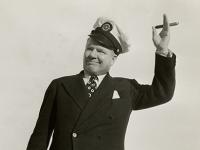Answer: William Claude Dukenfield
He went on to become a famous actor, but W. C. Fields was once a boy from Philadelphia who took up juggling as a way to escape poverty. Fields, whose real name was William Claude Dukenfield, was born on January 29, 1880. His family toiled to make ends meet and moved frequently around Philadelphia. Their earliest known address according to the 1880 census was 6320 Woodland Avenue in Philadelphia.
After running away from home at age 11, young Dukenfield apparently found work in Philadelphia (possibly at Strawbridge & Clothier) and took up juggling in his early teens. He worked as a juggler around Pottsville, Pennsylvania, and later Atlantic City, New Jersey. It’s thought that around this time he began going by the name W. C. Fields and was billed as “The Eccentric Juggler.” Though he initially struggled, his juggling act eventually took off. In the early 1900s he performed for King Edward VII at Buckingham Palace and joined the Ziegfeld Follies on Broadway.
Fields’s Broadway career led to work in silent films where he further developed his comedic style and persona. At the age of 51, made his sound debut in a film titled Her Majesty, Love (1931). Fields made several comedic shorts that were distributed by Paramount, and his rise in fame began. He became recognized for his characteristic drawl and jokes that often involved alcohol and women. Fields starred in more than 40 films and shorts between the 1910s and the 1940s and also appeared on radio in “Charlie McCarthy’s Old Time Radio Show.” Among his most popular features were those he made later in life such as My Little Chickadee (1940), The Bank Dick (1940), and Never Give a Sucker an Even Break (1941).
Fields died in 1946 and is buried in Forest Lawn Memorial Park Cemetery, in Glendale, California. He reportedly wanted his epitaph to include the phrase “I'd rather be in Philadelphia,” but this wish was not realized.
More images of W. C. Fields can be found in HSP's Philadelphia Record photograph morgue (#V07). For further information see W.C. Fields by Himself: His Intended Autobiography (PN 2287 .F45 A3 1973) and Man on the Flying Trapeze: The Life and Times of W.C. Fields (PN 2287 .F45 L68 1997).
Image: From a promotional photo for The Big Broadcast of 1938, Paramount Pictures, 1938

